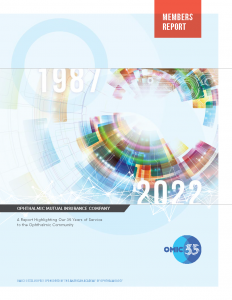OMIC Members Report 2022-2024
 WHEN OMIC OPENED FOR BUSINESS on October 1, 1987, it signaled not just the beginning of a new insurance company, but the culmination of a visionary plan to directly head off a growing threat facing our colleagues nationwide. Our 2022 Members Report highlights a 35-year journey protecting ophthalmology.
WHEN OMIC OPENED FOR BUSINESS on October 1, 1987, it signaled not just the beginning of a new insurance company, but the culmination of a visionary plan to directly head off a growing threat facing our colleagues nationwide. Our 2022 Members Report highlights a 35-year journey protecting ophthalmology.
OMIC Members Report
 |
OMIC Members Report | 2022
|
|
|
Managing Disruptive Patients
|
June 10, 2022 Dear OMIC Insureds: Healthcare workers are five times more likely to experience workplace violence than workers in all other industries. Between 2011 and 2018, injury arising from violence against medical professionals increased by 67%, according to the U.S. Bureau of Labor Statistics, and in 2018 it reported that 73% of all nonfatal workplace assaults and injuries occurred in healthcare settings. The World Health Organization estimates that up to 38% of healthcare workers suffer physical violence at some point in their careers, and many more will be the targets of threats and verbal abuse. Studies conducted since the onset of the pandemic suggest that this number is increasing. In 2020 Dye et al. found that health professionals were roughly 50% more likely than other community members to have been harassed, bullied, or hurt as a result of the COVID-19 pandemic. Fortunately, violent attacks by patients against staff and physicians in the clinical office are rare, but over the years insureds have reported incidents of stalking and physical harm by their patients. A more frequent occurrence are patients who are verbally abusive and threaten litigation. Triggers for aggressive behavior can include a multitude of items, such as receipt of a serious, vision-threatening diagnosis, an unexpected outcome after surgery, a billing issue, the requirement to adhere to protocols, or a long time in the waiting room. These episodes are sometimes accompanied by a demand for a refund or the threat of posting a negative review on social media. Since the pandemic began, we’ve listened to many insureds describe patients who have become agitated regarding compliance with safety precautions, and assert that their civil rights are being violated. One way to address aggressive behavior by patients, and reduce the stress resulting from such instances, is to be prepared for them:
If you have questions, contact us for confidential risk management advice at riskmanagement@omic.com or call us at 1-800-562-6642 and enter 4 for Risk Management. Sincerely, Linda D. Harrison, PhD
CONFIDENTIALITY NOTICE: This correspondence is intended only for the person or entity to which it is addressed and may contain information that is privileged, confidential or otherwise protected from disclosure. Dissemination, distribution or copying of this e-mail or the information herein by anyone other than the intended recipient, or an employee or agent responsible for delivering the message to the intended recipient, is prohibited. If you have received this e-mail in error, please notify us at riskmanagement@omic.com and destroy the original message and all copies.
|
ROP Safety Net Revision
| May 9, 2022
Dear Colleague: The International Classification of Retinopathy of Prematurity, Third Edition1 (ICROP3) was released last year. We revised the clinical tables and recommendations in our ROP Safety Net accordingly. ICROP3 changes updated in the OMIC Safety Net: · The definition of aggressive ROP replaces aggressive-posterior ROP · A continuous spectrum of vascular abnormality exists from normal to plus disease · Regression and reactivation should be documented Updated/new consent forms: · Update to informed consent to inject · Update to informed consent for laser · NEW: Telemedicine services consent Minor changes to the following letters: · Discharge from hospital · Transfer to treat · Transfer for other care · Missed appointment · Outpatient screening We are working on Spanish translation of the updated consent forms and letters. You should update your consent forms and letters immediately (even though Spanish translation is not available). You may access the revised clinical tables and the entire ROP Safety Net at http://www.omic.com/rop-safety-net/. Remember that you may contact the Risk Management Hotline for confidential assistance at riskmanagement@omic.com or 800-562-6642, option 4. Sincerely, Robert S. Gold, MD ________________________________________ 1 Chang MF, Quinn GE, Fielder AR, Wu WC, Zhao P, Zin A, et al. International Classification of Retinopathy of Prematurity, Third Edition. Ophthalmology. 2021;128(10):E51-E68. Available at: https://doi.org/10.1016/j.ophtha.2021.05.031 (Accessed: 3/10/22) CONFIDENTIALITY NOTICE: This correspondence is intended only for the person or entity to which it is addressed and may contain information that is privileged, confidential or otherwise protected from disclosure. Dissemination, distribution or copying of this e-mail or the information herein by anyone other than the intended recipient, or an employee or agent responsible for delivering the message to the intended recipient, is prohibited. If you have received this e-mail in error, please call me and destroy the original message and all copies.
|






